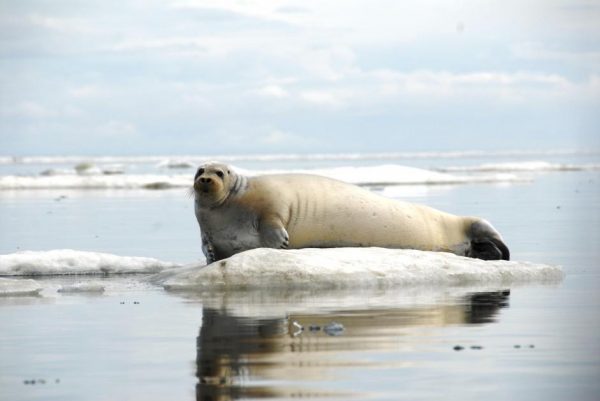
The coronavirus has disrupted research scheduled to take place in the Bering Strait this spring and summer. Even without researchers coming into the region from the outside, local and regional stakeholders are moving forward with an investigation into what caused five times the normal number of seals to wash up dead in the Bering and Chukchi seas since 2018.
“The skinny seals now, I don’t think anybody is harvesting them, they’re just washing up on the shores, the beaches; very skinny, they look like they have all their hair, no sores,” said Brandon Ahmasuk.
He represents the Bering Strait region and Kawerak on Alaska’s Ice Seal Committee. He also is the Vice President of Natural Resources at Kawerak. Ahmasuk says residents across the region are concerned about what’s been happening to the ice seals in recent years.
The National Oceanic and Atmospheric Administration (NOAA) is trying to determine what is causing an elevated number of stranded ice seals to wash up dead onshore, while other researchers seek to gather samples and data to that end, in the Bering Sea. But NOAA researchers are now unable to travel due to the coronavirus pandemic, and they’re being asked by Kawerak to suspend their research ventures in the Bering Strait region.
“We were hoping to document whether those previous two, very low sea ice years, [2018 and 2019], had impacts on the year classes of pups that would have been born in those years. We suspect there was low reproduction and low survival.”
Peter Boveng, the leader of NOAA’s Polar Ecosystem Program, was slated to spend weeks studying the health of ice-associated seals and their pups in the Bering and Chukchi Seas last month.
But due to restrictions related to the coronavirus, Boveng’s research cruise was postponed indefinitely, forcing the NOAA team to make do without his potential findings from this spring. It’s too early to tell when Boveng and his research team could reschedule their cruise. But he says the spring birthing season for ice seals, when sea ice is still present in the Bering Sea, is the ideal time for their research.
Bovengand his NOAA colleagues aren’t the only ones paying attention to the Unusual Mortality Event (UME) that’s affecting three different species of ice seals: bearded seals, spotted seals, and ringed seals.
“What we know about these species is based on a lot more than just our own research, and a big part of it is what we know and hear from people in the local communities,” said Boevang.
Gay Sheffield of Nome is the onsite coordinator for this UME under NOAA. According to her, the investigation team is testing seals for a slew of diseases like Phocine Distemper Virus (PDV), Avian Influenza, and even COVID-19, just to rule out some possible causes and address public concerns. Sheffield says they are also testing for toxoplasma (a single cell parasite Toxoplasma gondii detected in people, land animals and recently in monk seals), biotoxins from harmful algal blooms like saxitoxin and domoic acid, and potential injuries from fishing gear.
“We have not to this point gotten very many carcasses, whole carcasses to send, but those that were from 2017, 2018, and 2019 were in poor body condition. So, the leading hypothesis is with our marine ecosystem in transition, with the pollock moving in, the capelin going down in number, the Arctic cod going down in number and the pollock and the big cod coming in, is that maybe prey items are not as available,” said Sheffield.
Even though the exact cause for the 2011 UME was undetermined, Ahmasuk points out that this current event for ice seals is different from Western Alaska’s other UME.
“What I remember from 2011 to just a few years ago, is seals showing up with hair loss, almost complete hair loss, sores covering almost the whole body, very little blubber, oozing and stuff around the eyes…some of them had a bad smell,” he said.
Although some seals with hair loss or other signs similar to the 2011 UME may be found in the Bering Strait region today, Ahmasuk says the latest event from the last few years features more seals that are showing signs of starvation.
So, these stranded ice seals look different than they did during the last UME to hit the region, and potentially for a different reason. But Sheffield says there are even more differences between the last UME and the current one, like regional tribal communities being involved at a greater level.
“In Western and Northern Alaska, we go beyond conservation concerns and we have public health and food security concerns when we’re talking about bearded, ringed, and spotted seals,” said Sheffield.
So far only a few communities have called in to the handful of team meetings NOAA has hosted thus far, however Sheffield says the investigation is moving forward. She is also letting seal subsistence hunters know they can help the investigation by having their seals tested.
Required tissue samples include a D-cell battery sized chunk of lung and brain matter, as well as one to two feet of intestine from near the seal’s anus (uncleaned).
Lex Treinen is covering the state Legislature for Alaska Public Media. Reach him at ltreinen@gmail.com.





